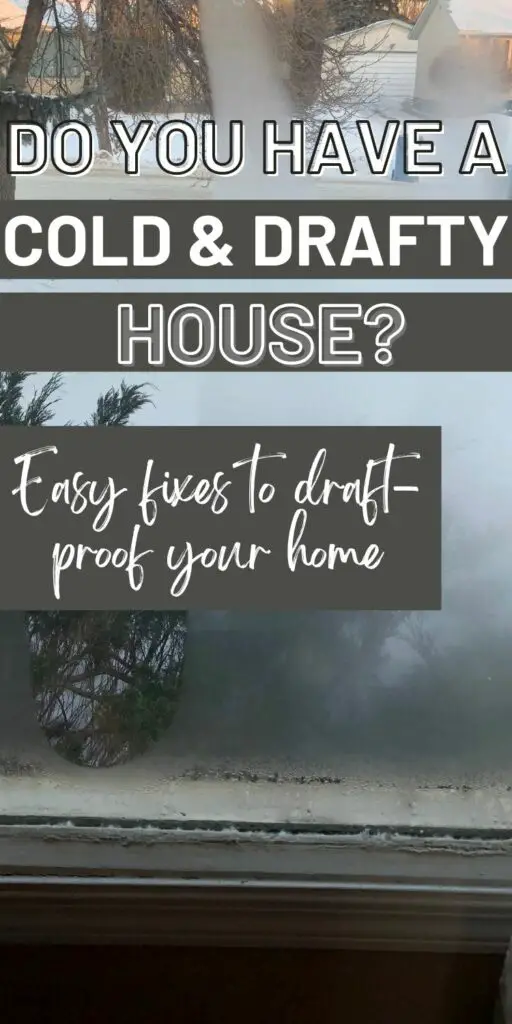We live in a fairly old house on the top of a hill surrounded by cleared farmland. While the location offers privacy and incredible views all year round, we also deal with bitter cold winter winds that find their way into our drafty home. Despite the house being well insulated, these cold air currents left us feeling a cold draft in the house.
I hate being cold, so I went on a mission to find budget friendly drafty house solutions to stop the cold drafts in our house and improve energy efficiency. Through trial and error, I found some quick and easy cold house solutions to draft proof our home and keep it warm without breaking the bank. As an extra bonus, it’s now also cooler in the summer!
If you’re asking yourself “why is my house so cold?” you just may find the answer in this post. There are many possible reasons why your house is cold that we have listed here. We also offer some easy cold house solutions to make the house warmer by eliminating the drafts that cause cold in the house.

As an Amazon Associate I earn from qualifying purchases. This means if you click on a link and buy something I’ve recommended, I get a small commission at no additional cost to you. You can see my full Disclosure Policy here.
Related Topic: What to do When Your House is Too Hot in Summer
Why is my house so drafty?
Hot air rises and cold air sinks, so the house drafts you feel are the vacuum effect of the cold air rushing up to replace the warm air that is being sucked out of the open cracks, gaps and holes in your home. These openings can usually be found around drafty doors and windows, making it feel cold in the house.
But that’s not the only place the cold air sneaks in. That cold draft in the house can also come in around plumbing and electrical outlets, or light fixtures and exhaust fans – basically anywhere there’s even a tiny hole or gap can leave you with draft walls.
Fireplace chimneys are also notorious for sucking warm air out of your home. Cold drafts at floor level can be caused by gaps in floorboards or baseboards over unheated crawl spaces, garages or basements.
Nonexistent or deteriorated insulation is also a common reason for drafts and increased energy bills.
RELATED POST: How to Keep Pipes from Freezing When It’s Really Really Cold Out
How to find cold drafts in your house
We found the easiest way of finding drafts in the house is to use a Thermal Heat Detector. This handy gadget requires a 9 volt battery and uses infrared sensors to help you pinpoint where the cold spots are located in your poorly insulated house. It’s the perfect DIY tool for finding those areas in your cold drafty room where the cold air is sneaking in.
Other ways of finding drafts in your house include running your hand around the edges of windows and doors to feel if there’s a breeze. You could look for cracks where light is coming through where it shouldn’t be. Or you could use a candle flame, incense smoke or even a tissue to help determine where drafts are getting in.

Drafty house solutions to fix a drafty house
Once you have determined the cause(s) of your drafts, there are many cheap ways to keep your cold house warm by sealing gaps. Here are some hacks to keep house warm by fixing drafty doors, drafty windows, and other areas that cause drafts in the house.
How to fix a drafty door
One of the main causes of a drafts in your home is a drafty door that makes it cold in house. There are many easy ways of sealing a drafty door, including tightening hinges, replacing weather stripping, installing a door sweep or draft stopper, sealing any windows and using plastic sheeting to trap heat in house so your money doesn’t literally go out the window.
Tighten hinges on drafty door
Check the door hinges to make sure loose hinge screws aren’t the cause of the drafty door. If the door is loose, tighten and lubricate the hinge screws to create a better seal and keep house warm.
Replace weather stripping
If your drafty house is caused by gaps in the sides or top of the door, replace the weather stripping on the drafty door. Weatherstripping is fairly easy to remove and reinstall, is energy efficient, and can usually be done in less than an hour.
Install a door sweep or draft stopper on drafty door
If your drafty door is caused by air coming in under the door, you can easily install a door sweep without removing the door. Alternatively, a draft stoppers can be easily installed to keep the cold air from blowing in underneath your drafty door. You can use pool noodles cut in half, then cut to the width of the door to slide under the door. Even rolled up towels can be used in a pinch.
Seal glass inserts and framing
Glass inserts on your door (door lites) are a common cause of drafty doors. Reseal the glazing with silicone sealant and let dry to eliminate drafts. You can use the same silicone sealant around the door frame to prevent drafts from seeping in around the door frame.
Fix drafty pet doors
Make sure the door flap isn’t broken and there is no dirt or debris preventing the flap from closing. Check the weather stripping for damage and replace it if necessary. Check any magnets to ensure they connect tightly. Reinforce flimsy flaps with a fitted plastic curtain, heavy towel or blanket. You could also add a second flap for more protection from drafts.
Use plastic on an unused drafty door
If you have an external drafty door that you don’t use, you can cover it with plastic to insulate it. Just purchase a roll of plastic and some 2 sided tape to quickly measure, cut and stick thick plastic over any door that you don’t use. It can be easily removed for quick exits if required.
RELATED POST: 3 Simple DIY disinfectant sprays that work!
How to seal drafty windows
If there are any gaps in your window assembly, you may feel a cold draft from windows. Sealing drafty windows can be quick and easy by locking the windows, installing storm windows, or using plastic sheets, styrofoam or bubble wrap to seal the windows. You can also use insulated curtains to block drafts from windows, reseal the windows or replace weather stripping to stop cold air coming through windows.
Make sure windows are locked
Sometimes, simply making sure your windows are locked is enough to complete the seal and eliminate drafts from windows.
RELATED POST: Hydrogen peroxide hacks you need to know
Install storm windows
If you have storm windows, a quick fix for drafty windows is to remember to reinstall them. Storm windows work together with single pane sash as a combined “unit” of increased efficiency.
Use clear plastic for drafty windows
An easy way to insulate windows is to add another layer of insulating air to reduce heat loss through the window with plastic. You can buy a roll of air sealing plastic and some 2 sided tape to quickly measure, cut and stick thick plastic over the drafty window. Or you could buy a shrink film window kit to apply the plastic and use a hair dryer to shrink it to fit.
Bubble wrap for drafty windows
Bubble wrap does work to help insulate windows as the air contained in the bubbles serves as multiple insulating pockets. The bubble wrap is very easy to apply. Spray a fine mist of water on the window and the bubble side of the bubble wrap. Fit the bubble wrap into the window and trim with a utility knife. The bubble wrap will stick to the window and insulate it until you decide to remove it by pulling it off. You can even save and reuse it!
Styrofoam sheets for drafty windows
If the view out of the window isn’t a priority, you can use styrofoam sheets inside drafty windows. Styrofoam is an effective insulator and simply placing sheets cut to fit into the window opening can help prevent drafty windows. They can easily be taped together and are also easily removable to take advantage of sunlight.
Insulated curtains for drafty windows
You can use thermal window curtains to stop window drafts. Keep them closed when it’s windy or dark or open them to let the warm sunshine in. You could even make your own with thick wool blankets.
Reseal drafty windows
The sealant, or caulking on windows can dry out and crack over time. Remove old caulking and reseal the windows with silicone sealant. Make sure to cover both the inside seams of the window as well as outside the frames to prevent leaks.
Replace weather stripping on drafty windows
Weatherstripping is used between moving parts of the interior of the window to plug any open spaces. You can check around the jambs, sashes, and panes to see if old weatherstripping is still in good shape. If not, you may be able to replace the strips yourself. You can even use a butter knife and push pieces of saran wrap into cracks and crevices for a cheap and easy way to stop cold air from coming in.
RELATED POST: How to blackout windows without breaking the bank
Fix drafty floors and baseboards
Gaps in floorboards can allow drafts up and into the room, especially if you are dealing with unheated areas below. Another source of drafts at floor level is gaps between the floorboards and the walls which send the frigid air out through the baseboards.
Sealing baseboards with caulking can help, along with using carpeting to cover the drafty areas. Make sure that the heating vents are blowing warm air. Inspect wood floors carefully for gaps between the boards. You can fill these gaps with sisal or jute rope to allow for the natural expansion and contraction of the wood.
Carpet for drafty floors
One way to stop drafts from coming through the floors is to add carpeting, preferably wall to wall. However, if you’ve determined that specific gaps are causing the problem, area carpets to cover those areas will help solve the problem. Carpet tiles are another way to cover floor drafts.
Check heating vents
If cold air is blowing out of your vents, you may have a dirty filter blocking airflow to your furnace. Change the furnace air filter and make sure the fan is set to AUTO so it only blows warm air.
Fill in the gaps causing drafty floors
Hardwood naturally expands and contracts, depending on the humidity level which tends to be lower in cold weather. This is why an expandable filler is recommended. Use Sisal or jute rope to fill the cracks. It comes in various sizes to fit the specific gaps.
Seal baseboards
The fastest and most effective way to fix baseboard drafts is with clear silicone caulk along the tops and bottoms of the baseboards. Make sure to seal any joints as well.

Fix a drafty fireplace
If you hate the cold draft sweeping through the room when it’s not in use, but love your wood burning fireplace, here are some quick drafty fireplace solutions.
Close the damper
One of the main reasons for a drafty fireplace is an open damper. Remember to close it when there is no fire. If you still feel a draft when the damper is closed, it’s time to replace the damper.
Use a fireplace blocker
An easy way to block fireplace drafts is by using a fireplace blocker. You can also make your own with a styrofoam insulation sheet or plywood cut to fit the opening. You can even block it with a sheet of thick plastic and tape if that’s what you have on hand.
RELATED POST: DIY shoe deodorizer: 16 ways to refresh stinky shoes
Other causes of a drafty house
Electrical outlets and light fixtures, especially around recessed lights, are some of the common places where air seeps into a room. Hidden cracks or holes around other built-in features of the home also allow cold air to sneak in. Here are some ideas to stop these other causes of a drafty house.
Gaps Around Electrical Outlets & Light Switches
Gaps around electrical outlets and light fixtures are common causes of cold drafts. To fix drafty walls, seal these gaps with foam insulation inserts. Simply unscrew the wall plate, cut the insert to size with a straightedge and sharp utility knife, then screw it back on under the plate. The pressure of the screws pulls against the plate and secures the seal in place.
Gaps Around Fixtures
If you have gaps around fixtures that are causing drafts in your home, you can seal them with some caulking. The best way is to lower the trim and apply a bead of caulking around the edge of the opening. Then put the trim back up into the caulking to completely seal any gaps. Or you could just carefully apply caulking around the trim without removing it if you’re not so handy.
Gaps in Cabinets
Built in cabinets can have gaps along the floors that cause drafts in your home. Depending on the size of the gap, you can either apply caulk along the gap, or you can fill it in with spray foam insulation. If there’s a draft originating inside the cabinets, you can line the walls with cut styrofoam sheets to insulate and tape to seal up the gaps.

Drafts from milk doors, dumbwaiters and laundry chutes in older homes
Our older house has a milk delivery door. We stuffed it with some insulation and sealed both the inside and outside doors with caulking. Older homes may also have dumbwaiters, laundry chutes or other unique features that can be sealed using a combination of any of the drafty house solutions mentioned above to stop the drafts. Unique situations need unique solutions, so use the method that works best for your situation.
How to keep an old drafty house warm
As we’ve outlined, the best way to keep an old drafty house warm is to seal all holes, gaps, and cracks in doors and windows. Then find other causes of drafts in your home and seal them as well. Just a little troubleshooting and sealing is really all it takes to draft-proof your home.
Of course, there may be more serious issues such as missing insulation in your attic or walls, but these easy steps will minimize drafts and save on heating bills until you can get the larger job done.


ty for information